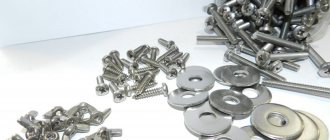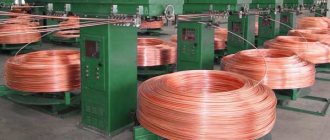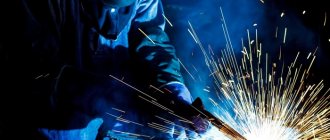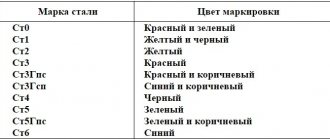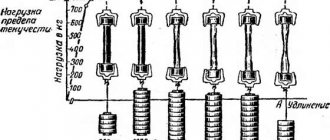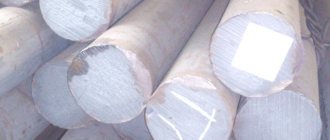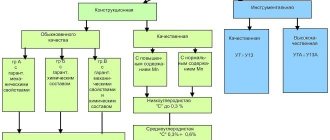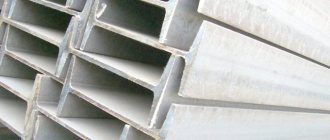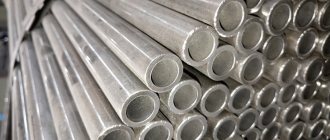Steel strength classes and quality category for cold resistance
For the purpose of unification, steels used in structural metal structures are divided into seven main levels (classes) of strength according to guaranteed values of yield strength and tensile strength
Class C 225 steel (from > 225 MPa) is conventionally called normal strength steel, the next three classes (from > 285 > 325 > 390 MPa) are called high-strength steel, and the remaining three classes (from > 440 > 590 > 735 MPa) are steel high strength.
Table of strength classes and quality groups for cold resistance of rolled construction steels
| Conditional strength class | Former designation | Mechanical properties under tension | Temperature at which impact strength KCU is guaranteed to be at least 0.3 M J/m2, for cold resistance quality groups | ||||
| yield strength, MPa | tensile strength, MPa | relative extension, % | |||||
| no less | I | II | III | ||||
| S225 | C38/23 | 225 | 375 | 25 | Not guaranteed | –20 | – |
| S285 S325 S390 S440 S590 S735 | С44/29 С46/33 С52/40 С60/45 С70/60 С85/75 | 285 325 390 440 590 735 | 430 450 510 590 685 830 | 21 21 19 16 12 10 | – – – – – – | –40 –40 –40 –40 –40 –40 | –70 –70 –70 –70 –70 –70 |
Typically, the first strength class corresponds to rolled carbon steel of ordinary quality in a hot-rolled state, subsequent strength classes from the second to fifth - rolled low-alloy steel in a hot-rolled or normalized state, the sixth and seventh strength classes - rolled economically alloyed steel, supplied, as a rule, in a thermally improved state . However, it is also possible to obtain rolled products of the second and third classes by thermal and thermomechanical hardening or controlled rolling.
Along with the requirement of guaranteed strength, construction steels are also required to have guaranteed resistance to brittle fracture (cold resistance). It is regulated by impact strength indicators at negative temperatures and at temperatures of plus 20 ° C after mechanical aging. All construction steels can be divided into three groups based on cold resistance:
- I - without guaranteed cold resistance;
- II - with guaranteed cold resistance for metal structures operated under normal temperature conditions (design temperature not lower than minus 40 ° C);
- III - with guaranteed cold resistance, but for structures operated at a design temperature below minus 40 ° C (“northern version”).
The table shows the test temperature at which the impact strength of steel of each quality group for cold resistance must be guaranteed. The specified groups correspond to certain steel grades and quality categories provided for by steel standards. Thus, according to GOST 27772-88*, group I corresponds to steel C235, group II - steel C255 and C285, steel C345 and C375 categories 1 and 3, steel C590, group III - steel C345 and C375 categories 2 and 4, steel C590K.
All test temperatures in the table (as in GOST 27772-88*) are indicated for the conditions for determining the impact strength KCU on standard samples with a semicircular notch (radius 1 mm) type I according to GOST 9454-78*, cut from sheets and a wide strip in the direction across the rolling direction, and from shaped profiles and high-quality steel - along the rolling direction. At the same time, recently the question of transition, when certifying steel, to more stringent conditions for determining impact strength KCV on samples with a sharp triangular cut (radius 0.25 mm) type II according to GOST 9454-78* has been urgently raised. The use of these samples is in accordance with international practice.
According to existing methodological studies, there is no single transition from KCU standards to KCV standards, common for all metal products, and it is necessary to take into account individual characteristics, including both the type of rolled metal and the quality of the steel. However, what is common to such a transition is the need to increase the test temperature, which for rolled construction steel of equivalent cold resistance, all other things being equal (the same direction of sample cutting, the same metrologically substantiated value of impact strength 0.3 mJ/m2) is approximately 40 °C. Thus, the KCU standards at minus 40 °C and minus 70 °C will closely correspond to the KCV standards at 0 °C and minus 30 °C.
Under the influence of fluctuations in the content of elements in the range of grade composition, the heterogeneity of the ingot and rolling conditions, the strength characteristics of steel of each grade vary widely. The desire to more fully use the actual strength of rolled steel in structures led to the idea of selective division at metallurgical plants of the entire range of metal products of a given grade into separate strength groups, distinguished by guaranteed values of yield strength and tensile strength.
In our country, such a division into strength groups was carried out for construction carbon and low-alloy steel grades of the first, second and third strength classes [26] and is reflected in TU 14-1-3023-80 and GOST 27772-88*. According to these standards, each grade of carbon and low-alloy steel is divided into two strength groups, and for the second group the guaranteed values of the yield strength and tensile strength are 10-40 MPa higher than for the first. High reliability of compliance with strength and ductility standards (with a probability of at least 95%) is ensured by special statistical acceptance and control procedures. Rolled metal supplied according to these standards is called steel with a guaranteed level of mechanical properties, differentiated by strength groups.
Types of steels and features of their markings
Various areas of application of steel require that it have strictly defined properties - physical, chemical. In one case, the highest possible wear resistance is required, in others, increased resistance to corrosion, in others, attention is paid to magnetic properties.
There are many types. The bulk of the smelted metal goes into the production of structural steel, which includes the following types:
- Construction Low alloy steel with good weldability. The main purpose is the production of building structures.
- Spring. They have high elasticity, fatigue strength, and fracture resistance. Used for the production of springs and leaf springs.
- Bearing. The main criterion is high wear resistance, strength, low fluidity. It is used for the production of units and components of bearings for various purposes.
- Corrosion resistant (stainless). High-alloy steel with increased resistance to aggressive substances.
- Heat resistant. It is distinguished by its ability to work for a long time under load at elevated temperatures. Area of application: engine parts, including gas turbine engines.
- Instrumental. Used for the production of metal and woodworking and measuring instruments.
- Fast cutting. For the manufacture of tools for metalworking equipment.
- Cementable. It is used in the manufacture of parts and assemblies operating under high dynamic loads under conditions of surface wear.
Read also: Dividing head for a metal lathe
When deciphering the designations, it is necessary to take into account that each of the types corresponds to a strictly defined letter in the marking.
Designations of alloying elements
In order to recognize the qualitative and quantitative composition from the markings, letter designations are used for alloying elements. Basically, Russian letters correspond to the names of elements, although there are exceptions, since there are elements that begin with the same letters. The table of alloying elements is as follows.
Designation of alloying elements in steels
B
| Tungsten | B | Niobium | |
| TO | Cobalt | E | Selenium |
| M | Molybdenum | R | Bor |
| N | Nickel | F | Vanadium |
| T | Titanium | C | Zirconium |
| X | Chromium | YU | Aluminum |
| G | Manganese | A | Nitrogen |
| D | Copper | WITH | Silicon |
As can be seen from the table, it contains two non-metals - silicon and nitrogen, but no carbon. The presence of carbon is implied in the composition of any steel, therefore the designation indicates only its content
Tensile strength
A certain threshold value for a specific material, exceeding which will lead to the destruction of the object under the influence of mechanical stress. The main types of strength limits: static, dynamic, compressive and tensile. For example, the tensile strength is the limit value of a constant (static limit) or variable (dynamic limit) mechanical stress, exceeding which will rupture (or unacceptably deform) the product. Unit of measurement: Pascal [Pa], N/mm² = [MPa].
Composition of steel alloys
The properties of the metal depend on the crystal lattice formed , which, in turn, is determined by the carbon content. The dependence of lattice types on the amount of carbon is clearly visible in the structure diagram. If, for example, there is up to 0.06% carbon in the steel lattice, then this is classic ferrite, which has a granular structure. This material is fragile, but fluid and has a high impact strength limit.
According to the structure of steel, they are divided into:
- ferritic;
- pearlite-ferrite;
- cementite-ferritic;
- cementite-perlite;
- pearlite
Carbon Additives and Strength
The law of additivity is confirmed by the percentage changes in cementite and ferrite in steel. If the amount of carbon additive is about 1.2%, the yield strength of the steel material is increased and the hardness, strength and temperature resistance are improved. With a subsequent increase in carbon content, the technical parameters deteriorate. Steel is difficult to weld and is difficult to stamp. Alloys with a low carbon content behave best when welding.
Manganese and silicon
Manganese is additionally added as an additive to increase the degree of deoxidation. In addition, this element reduces the harmful effects of sulfur. The manganese content is usually no more than 0.8% and it does not affect the technological properties of the alloy. Present as a solid component.
Silicon also does not particularly affect the characteristics of the metal. It is necessary to increase the quality of welding parts. The content of this element does not exceed 0.38% and it is added during the deoxidation process.
Sulfur and phosphorus
Sulfur is contained in the form of brittle sulfites. An increased amount of this element affects the mechanical properties of the alloy. The more sulfur, the worse the ductility, fluidity and viscosity of the alloy. If the 0.06% limit is exceeded, the product is more susceptible to corrosion and becomes susceptible to severe abrasion.
The presence of phosphorus increases the fluidity index, but at the same time the plasticity and viscosity decreases. In general, an excessive phosphorus content significantly deteriorates the quality of the metal. The combined high content of phosphorus and carbon has a particularly harmful effect on the characteristics. Acceptable limits for phosphorus content are considered to be values from 0.025 to 0.044%.
Nitrogen and oxygen
These are non-metallic impurities that reduce the mechanical properties of the alloy. If the oxygen content is more than 0.03%, then the metal ages faster, and the values of ductility and viscosity decrease. Nitrogen additives increase strength, but in this case the yield strength decreases. The increased nitrogen content makes steel brittle and contributes to the rapid aging of the metal structure.
Behavior of alloying additives
To improve all the physical characteristics of steel, special alloying elements are added to the alloy. Such additives can be tungsten, molybdenum, nickel, chromium, titanium and vanadium. Joint addition in the required proportions gives the most acceptable results.
Alloying significantly increases fluidity, impact strength and prevents deformation and cracking.
Alloying additives in alloys
These are substances deliberately added to the melt to improve the properties of the alloy and bring its parameters to the required ones. Some of them are added in large quantities (more than a percent), others in very small quantities. I most often use the following alloying additives:
- Chromium. Used to increase hardenability and hardness. Share – 0.8-0.2%.
- Bor. Improves cold brittleness and radiation resistance. Share – 0.003%.
- Titanium. Added to improve the structure of Cr-Mn alloys. Share – 0.1%.
- Molybdenum. Increases strength characteristics and corrosion resistance, reduces fragility. Share – 0.15-0.45%.
- Vanadium. Improves strength parameters and elasticity. Share – 0.1-0.3%.
- Nickel. Promotes an increase in strength characteristics and hardenability, but at the same time leads to an increase in fragility. This effect is compensated by the simultaneous addition of molybdenum.
Read also: DIY waste oil drip burner
Metallurgists also use more complex combinations of alloying additives, achieving unique combinations of physical and mechanical properties of steel. The cost of such grades is several times (or even tens of times) higher than the cost of conventional low-carbon steels. They are used for particularly critical structures and assemblies.
If you find an error, please select a piece of text and press Ctrl+Enter.
Modern production requires a large number of durable steel products. Various steels are used in the construction of bridges, houses, and complex structures. One of the most important issues is the calculation of the strength of the metal and the stress value of the steel reinforcement. In order for structures to serve for a long time and be safe, it is necessary to accurately know the yield strength of the steel material that is subject to the main load.
Marking of steels according to Russian standards
Marking steel according to Russian standards makes it possible to determine the composition of the metal and, in part, whether it belongs to a certain type.
If the presence of carbon in steel is more than 1%, its amount is not indicated in the marking. The steel grade includes letter designations of alloying additives indicating their quantity in tenths and hundredths of a percent, but if the component content is less than 1.5%, then only the letter designation is present in the marking.
Read also: How does a magnet work on an antimagnetic filling?
In addition to the chemical composition, the marking contains symbols characterizing the purpose of the steel and the degree of its quality.
How is strength testing performed?
Strength tests for tensile strength are carried out on special test benches. One end of the test sample is fixedly fixed in them, and a drive mount, electromechanical or hydraulic, is attached to the other. This drive creates a smoothly increasing force that acts to break the sample, or to bend or twist it.
Tensile test
The electronic control system records the tensile force and relative elongation, and other types of deformation of the sample.
Tensile strength of cast iron
The method for determining the tensile strength of cast iron is regulated by GOST 27208-87 (Cast iron castings. Tensile tests, determination of tensile strength).
Tensile strength of gray cast iron
.
Gray cast iron (GOST 1412-85) is marked with the letters SCH, the letters are followed by numbers that indicate the minimum value of the cast iron's tensile strength - tensile strength (MPa * 10 -1). GOST 1412-85 applies to cast iron with flake graphite for castings of grades SCh10-SCh35; From here it can be seen that the minimum values of the tensile strength of gray cast iron
in the cast state or after heat treatment vary from 10 to 35 kgf/mm 2 (or from 100 to 350 MPa). Exceeding the minimum tensile strength of gray cast iron is allowed by no more than 100 MPa, unless otherwise specified.
Tensile strength of ductile iron
. The marking of high-strength cast iron also includes numbers indicating the tensile strength of cast iron (tensile strength), GOST 7293-85. The tensile strength of ductile iron is 35-100 kg/mm 2 (or from 350 to 1000 MPa).
From the above it is clear that nodular cast iron can successfully compete with steel.
Prepared by: Kornienko A.E. (ICM)
Lit.:
- Zimmerman R., Gunter K. Metallurgy and materials science. Ref. ed. Per. with him. – M.: Metallurgy, 1982. – 480 p.
- Ivanov V.N. Dictionary-reference book for foundry production. – M.: Mechanical Engineering, 1990. – 384 p.: ill. — ISBN 5-217-00241-1
- Zhukovets I.I. Mechanical testing of metals: Textbook. for medium Vocational school. — 2nd ed., revised. and additional – M.: Higher school, 1986. – 199 p.: ill. — (Vocational education). — BBK 34.2/ ZH 86/ UJ 620.1
- Shtremel M.A. Strength of alloys. Part II. Deformation: Textbook for universities. - M.: *MISIS*, 1997. - 527 p.
- Meshkov Yu.Ya. Physics of steel destruction and current issues of structural strength // Structure of real metals: Collection of articles. scientific tr. - Kyiv: Nauk. Dumka, 1988. - P.235-254.
- Frenkel Ya.I. Introduction to the theory of metals. Fourth edition. - L.: “Science”, Leningrad. department, 1972. 424 p.
- Preparation and properties of nodular cast iron. Edited by N.G. Girshovich. - M.,L.: Leningrad branch of Mashgiz, 1962, - 351 p.
- Bobylev A.V. Mechanical and technological properties of metals. Directory. - M.: Metallurgy, 1980. 296 p.
Strength of metals
Physics of strength
founded by Galileo: summarizing his experiments, he discovered (1638) that in tension or compression, the fracture load
P
for
a given material depends only on the cross-sectional area
F. This is how a new physical quantity appeared - stress σ=P
/
F
- and a physical constant of the material: fracture stress [4].
Physics of fracture as a fundamental science of the strength of metals
arose in the late 40s of the XX century [5]; this was dictated by the urgent need to develop scientifically based measures to prevent the increasingly frequent catastrophic destruction of machines and structures. Previously, in the field of strength and destruction of products, only classical mechanics was taken into account, based on the postulates of a homogeneous elastic-plastic solid body, without taking into account the internal structure of the metal. The physics of destruction also takes into account the atomic-crystalline structure of the metal lattice, the presence of defects in the metal lattice and the laws of interaction of these defects with elements of the internal structure of the metal: grain boundaries, second phase, non-metallic inclusions, etc.
Great influence on the strength of the material
is influenced by the presence of surfactants in the environment that can be strongly adsorbed (moisture, impurities); the tensile strength decreases.
Increasing the strength of a metal is caused by targeted changes in the metal structure, including modification of the alloy.
Educational film about the strength of metals (USSR, year of release:
